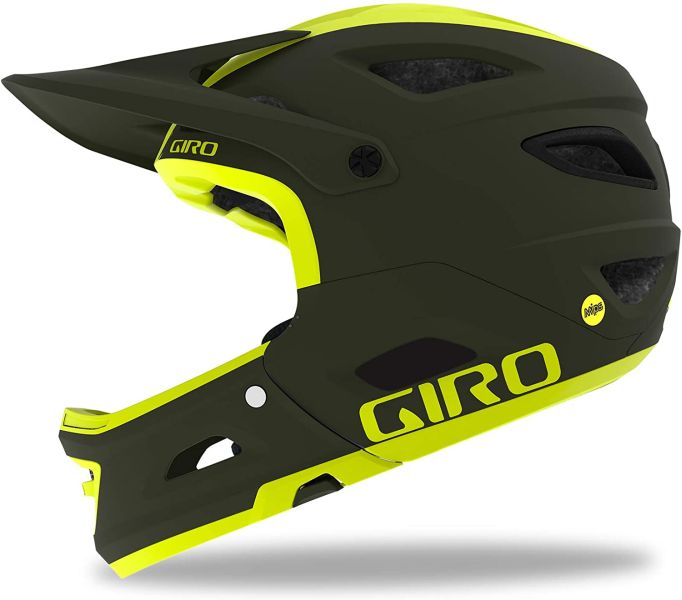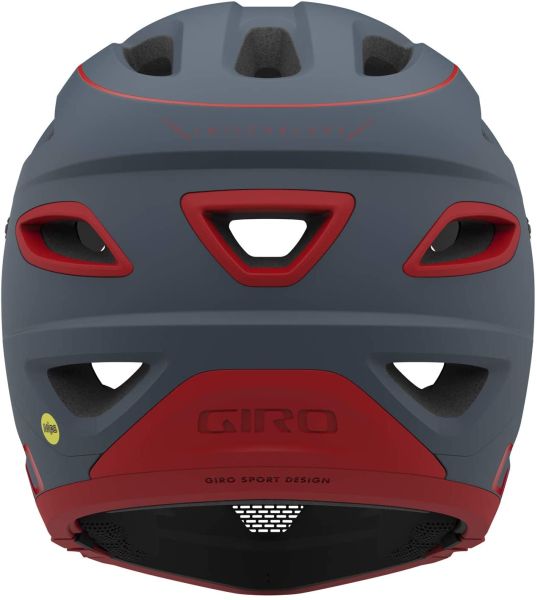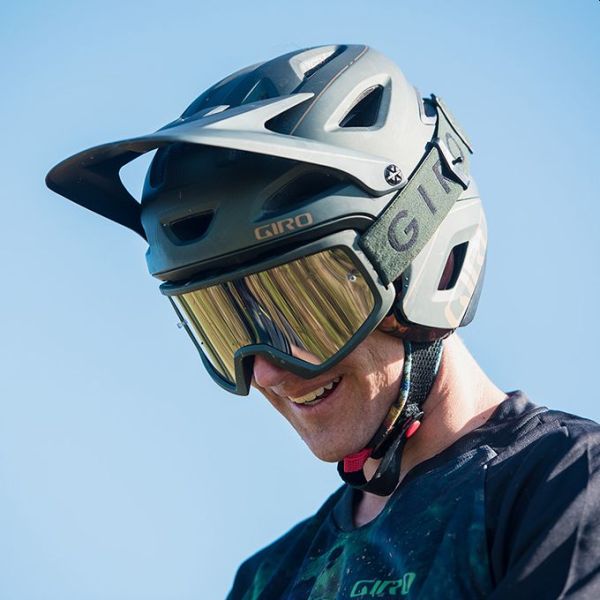Giro Switchblade has been around for a few years and is still going strong. The helmet has received upgrades along the way to make it better, but the overall form and function remain unhampered.
We take a closer look at this helmet with this Giro Switchblade review and see what’s remarkable about this helmet.
Giro Switchblade MIPS Highlights
Pros
- Downhill certified with and without chinbar (ASTM, CPSC)
- Excellent safety
- Good visor management
- Good features
Cons
- The chinbar attachment system could be better
- Average ventilation
Features Of Note For The Giro Switchblade
Working With The Chinbar
Since this is a convertible helmet the chinbar deserves some limelight. Giro has tried to make it easy to install and remove the chinbar from the Switchblade. It relies on metal guide bars and hooks to hold the chinbar in place. These go into the main helmet and you’ll hear a click sound to affirm that the chinbar has been locked in place.
It sounds fairly simple and reliable. In practice, it’s a bit more challenging. It takes time to get used to adding and removing the chinbar. The attachment can also be a bit finicky. They don’t seem very reliable and considering that there is an element of force involved, there’s a good chance they won’t last nearly as long.
Interestingly, given the shape and general appearance of this helmet, the chinbar is somewhat smaller than other convertible helmets. This is largely down to the Giro Switchblade having full-time ear protection. The chinbar here attaches to the cheeks of the helmet, rather than being the cheeks of the helmet.
About The Fit And Sizing
Giro Switchblade is available in three sizes
- Small (51-55 cm)
- Medium (55-59 cm)
- Large (59-63 cm)
Further tuning is available thanks to the Roc Loc Air DH fit system. The system allows adjustments to the helmet vertically and along the circumference. When fully set up, it leaves a bit of room above the head for ventilation. Simply put, air intake from the front moves to the back for exhaust.
The dial for the system is available at the back and sits right below the skull for easy adjustment. It remains easy to access and can be managed even with gloved hands. With the chinbar attached, the system works as well as any of Giro’s full-face helmets.

Giro Switchblade convertible MTB helmet likes to take on a heavy-duty look. In that sense, it uses thick chin straps that look very reliable. They can also be uncomfortable. The slight padding should add to the comfort, and yes, they initially feel good. But it also adds to the heat, and these straps can feel too big and often make the biker feel hot.
The D-ring closure for the straps may add to their robustness, but it also adds to their clunkiness. It can be a bit of an effort to get these straps on or off, as compared to the conventionally used Fidlock system.
Ventilation For This Helmet
A total of 24 vents are available on this helmet. And of course, they’re necessary, considering the helmet can go full-face. Even without the chinbar, this is a pretty big helmet, considering the ear enclosure is a part of the main body.
Given the general shape and size of the helmet, ventilation becomes an even more important concern. As does the question:
Do your ears get hot?
I was very much prepared for the ears to get hot and uncomfortable while wearing this helmet. Thankfully, that’s no problem. Ears might get warm, but they’re no more uncomfortable than a conventional full-face helmet or a convertible helmet (with attached chin bar).
As for regular ventilation, Switchblade handles it pretty well. It’s not quite as good as the Bell Super 3R MIPS helmet for ventilation, but it isn’t dismal either.

Overall, I’d say the ventilation is better than average. It’s not quite impressive, but it won’t leave you feeling uncomfortable either. It’s worth mentioning that Giro has improved the ventilation for the Giro Switchblade since its launch.
The previous helmets were more on the side of hot and clunky. Newer models don’t suffer from that problem. Bottom line: these have fairly good ventilation, that can be objectively considered to be better than average for this category.
Weight
Given its construction, Giro Switchblade’s weight merits additional consideration. With the chinbar attached, the helmet weighs around 34.6 ounces (980 grams) for the medium size. Remove the chinbar, and the helmet’s weight comes to nearly 24.2 ounces (685 grams).
Since it includes permanent ear covers, the main helmet is larger in size than most of its competition. So its weight is acceptable.
Giro Switchblade can be slightly heavier than some convertible helmets, but it is lightweight as compared to many full face helmets. Even those fond of enduro biking will find this helmet largely acceptable, though it can be a bit of a problem with long uphill climbs.
Overall, even considering that there are lighter helmets around, I’d say Giro Switchblade is an acceptably lightweight helmet.
Visor(s) For The Switchblade
Two visors are included with the Giro Switchblade package. The POV Plus visor is akin to conventional visors available on other Giro helmets. I’d say it’s very similar to the one on the Giro Montaro helmet. And yes, just like that, it can also feel a bit too long.
You can move this visor easily. When lifted, the visor leaves enough room to place goggles below it. That way, you can move your goggles and place them over the head without struggling with the visor. Integrated strap grippers will keep the visor in place.
The bolts securing the visor are sturdy and will keep it in position. Three indexed points are available for positioning the visor without the need to loosen any bolts.
The second visor available with the Giro Switchblade is a smaller one. This one’s geared more towards bikers who’d prefer to take a GoPro or similar camera along on their ride. It’s slightly smaller than the POV Plus visor and includes a place to mount the camera.
Comfort, Construction, And Safety Features
How Comfortable Is This Helmet?
Giro Switchblade is unique in the sense that it covers the ears as part of the main body of the helmet. Since the helmet will always be over the ears, with or without the chinbar, they’ve been careful with comfort. It stays well in position and offers a great feel over the ears.
It doesn’t quite trouble hearing either, which remains largely unaffected. Of course, there is some change, but hearing isn’t muffled, so it isn’t problematic.

Most bikers won’t experience any pressure points, which is another plus. It does leave a bit of an empty space above the crown of the head, which can feel odd at times. I presume this is a way to improve ventilation. So while it’s not ideal, it isn’t troubling either.
Other features include antimicrobial hydrophilic pads that claim to hold about 10 times their weight in sweat. While I can’t vouch for those numbers, the helmet doesn’t seem to get sweat rolling down your face. Additional pads are included in the box, in case you want more customization.
As previously stated, the straps are large and padded. They feel great against the skin. But for longer rides, especially in warmer weather, they can get uncomfortable and hot.
Overall, considering the ventilation, padding, straps, and the general feel, I’d consider this a fairly comfortable helmet.
Safety Features Of The Giro Switchblade
Safety is where this helmet doesn’t skimp at all. You could reasonably consider this helmet to be amongst the best in safety tech. Even with the chinbar removed, the Switchblade offers considerable protection for the category of open face helmets. That’s partly thanks to the ear covering construction of the helmet, which offers remarkable benefits for safety too.
The in-mold construction and safety tech used here put this helmet ahead of its competition. It’s indeed a tough job taking on the Giro Switchblade in the safety arena. There’s also the MIPS layer which provides additional protection for this helmet.
Giro Switchblade is certified for ASTM-1952-DH, CPSC, and EN-1078. The DH certification is valid for half-shell as well as full-face modes. Giro says the helmet is optimized for descent, and all those certifications do seem to agree with that assertion!
The Bottom Line For The Giro Switchblade Helmet
A premium, convertible MTB helmet, the Switchblade is definitely something to consider. As we see in this Giro Switchblade review, the helmet is a remarkable pick for its features and safety tech. It’s also on the more expensive side of things, so it’s probably a good idea to consider its value.
Giro Switchblade MIPS helmet is acceptably lightweight, has good ventilation, remarkable features, and excellent safety tech. I think it’s worthwhile to question the durability of the helmet – especially with regards to the chinbar connecting to the helmet. Other than that, however, it does pretty good on most counts.
